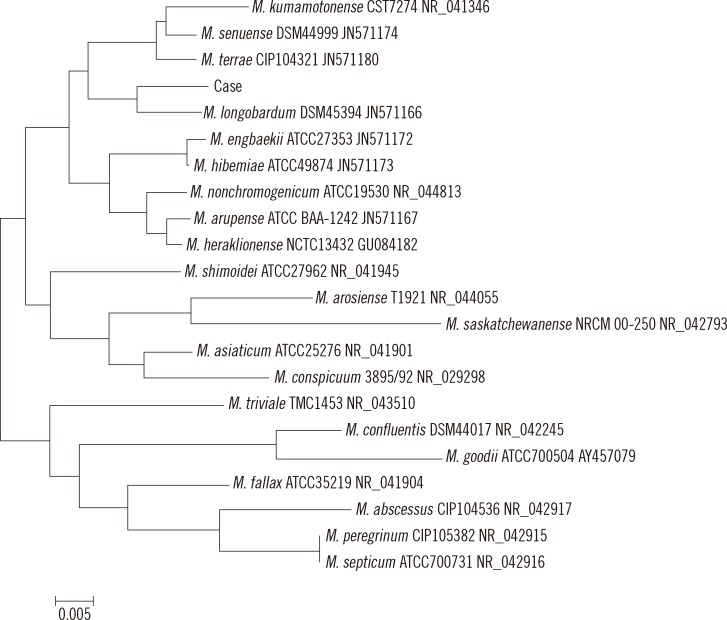Ann Lab Med.
2013 Sep;33(5):356-359. 10.3343/alm.2013.33.5.356.
First Case of Mycobacterium longobardum Infection
- Affiliations
-
- 1Department of Laboratory Medicine, Seoul National University Hospital, Seoul, Korea. euichong@snu.ac.kr
- 2Department of Orthopedics, Seoul National University Hospital, Seoul, Korea.
- 3Department of Internal Medicine, Seoul National University Hospital, Seoul, Korea.
- KMID: 1781342
- DOI: http://doi.org/10.3343/alm.2013.33.5.356
Abstract
- Mycobacterium longobardum is a slow-growing, nontuberculous mycobacterium that was first characterized from the M. terrae complex in 2012. We report a case of M. longobardum induced chronic osteomyelitis. A 71-yr-old man presented with inflammation in the left elbow and he underwent a surgery under the suspicion of tuberculous osteomyelitis. The pathologic tissue culture grew M. longobardum which was identified by analysis of the 65-kDa heat shock protein and full-length 16S rRNA genes. The patient was cured with the medication of clarithromycin and ethambutol without further complications. To the best of our knowledge, this is the first report of a M. longobardum infection worldwide.
MeSH Terms
-
Aged
Anti-Bacterial Agents/therapeutic use
Bacterial Proteins/genetics
Chaperonin 60/genetics
Clarithromycin/therapeutic use
Elbow/pathology
Ethambutol/therapeutic use
Humans
Male
Mycobacterium Infections, Nontuberculous/*microbiology
Nontuberculous Mycobacteria/classification/genetics/*isolation & purification
Osteomyelitis/diagnosis/drug therapy/*microbiology/pathology
RNA, Ribosomal, 16S/genetics
Treatment Outcome
Anti-Bacterial Agents
Bacterial Proteins
Chaperonin 60
Clarithromycin
Ethambutol
RNA, Ribosomal, 16S
Figure
Reference
-
1. Tortoli E, Gitti Z, Klenk HP, Lauria S, Mannino R, Mantegani P, et al. Survey of 150 strains belonging to the Mycobacterium terrae complex and description of Mycobacterium engbaekii sp. nov., Mycobacterium heraklionense sp. nov. and Mycobacterium longobardum sp. nov. Int J Syst Evol Microbiol. 2013; 63:401–411. PMID: 22447702.2. Cloud JL, Meyer JJ, Pounder JI, Jost KC Jr, Sweeney A, Carroll KC, et al. Mycobacterium arupense sp. nov., a non-chromogenic bacterium isolated from clinical specimens. Int J Syst Evol Microbiol. 2006; 56:1413–1418. PMID: 16738122.3. Kazda J, Cooney R, Monaghan M, Quinn PJ, Stackebrandt E, Dorsch M, et al. Mycobacterium hiberniae sp. nov. Int J Syst Bacteriol. 1993; 43:352–357. PMID: 7684243.4. Masaki T, Ohkusu K, Hata H, Fujiwara N, Iihara H, Yamada-Noda M, et al. Mycobacterium kumamotonense sp. nov. recovered from clinical specimen and the first isolation report of Mycobacterium arupense in Japan: novel slowly growing, nonchromogenic clinical isolates related to Mycobacterium terrae complex. Microbiol Immunol. 2006; 50:889–897. PMID: 17116985.5. Mun HS, Park JH, Kim H, Yu HK, Park YG, Cha CY, et al. Mycobacterium senuense sp. nov., a slowly growing, non-chromogenic species closely related to the Mycobacterium terrae complex. Int J Syst Evol Microbiol. 2008; 58:641–646. PMID: 18319471.6. Griffith DE, Aksamit T, Brown-Elliott BA, Catanzaro A, Daley C, Gordin F, et al. An official ATS/IDSA statement: diagnosis, treatment, and prevention of nontuberculous mycobacterial diseases. Am J Respir Crit Care Med. 2007; 175:367–416. PMID: 17277290.
Article7. Smith DS, Lindholm-Levy P, Huitt GA, Heifets LB, Cook JL. Mycobacterium terrae: case reports, literature review, and in vitro antibiotic susceptibility testing. Clin Infect Dis. 2000; 30:444–453. PMID: 10722426.8. Milne BW, Arnold MH, Hudson B, Coolican MR. Infectious arthritis of the knee caused by Mycobacterium terrae: a case report. J Orthop Surg (Hong Kong). 2009; 17:103–108. PMID: 19398805.9. Koh WJ, Choi GE, Lee NY, Shin SJ. Nontuberculous mycobacterial lung disease caused by Mycobacterium terrae in a patient with bronchiectasis. Tuberc Respir Dis. 2012; 72:173–176.10. Böddinghaus B, Rogall T, Flohr T, Blöcker H, Böttger EC. Detection and identification of mycobacteria by amplification of rRNA. J Clin Microbiol. 1990; 28:1751–1759. PMID: 2203812.
Article11. Kirschner P, Springer B, Vogel U, Meier A, Wrede A, Kiekenbeck M, et al. Genotypic identification of mycobacteria by nucleic acid sequence determination: report of a 2-year experience in a clinical laboratory. J Clin Microbiol. 1993; 31:2882–2889. PMID: 7505291.
Article12. Clinical and Laboratory Standards Institute. Interpretive criteria for identification of bacteria and fungi by DNA target sequencing; Approved guideline, MM18-A. Wayne, PA: Clinical and Laboratory Standards Institute;2008.13. Kim HY, Kook Y, Yun YJ, Park CG, Lee NY, Shim TS, et al. Proportions of Mycobacterium massiliense and Mycobacterium bolletii strains among Korean Mycobacterium chelonae-Mycobacterium abscessus group isolates. J Clin Microbiol. 2008; 46:3384–3390. PMID: 18753344.
- Full Text Links
- Actions
-
Cited
- CITED
-
- Close
- Share
- Similar articles
-
- A Case of Mycobacterium chelonae Infection at the Site of Acupuncture
- Two Cases of Cutaneous Mycobacterium abscessus Infection after Mesotherapy
- Mycobacterium chelonae Skin Infection after Autologous Fat Transplantation
- Disseminated Mycobacterium chelonae Infection in an Immunosuppressed Patient
- A Case of Pulmonary and Endobronchial Mycobacterium avium Infection Presenting as an Acute Pneumonia in an Immunocompetent Patient



